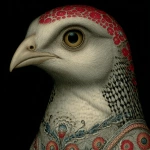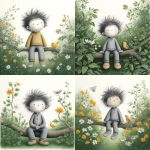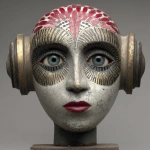Explore the Best AI Image Gallery

Beyond the Canvas: Wearable Tech as a Creative Catalyst
The realm of creativity is in constant flux, perpetually shaped by emerging technologies. Today, wearable technology stands at the forefront of this evolution, acting as a potent catalyst for artistic expression and innovation. From interactive garments to augmented reality experiences, wearables are blurring the lines between the physical and digital worlds, empowering creators with unprecedented tools to explore new mediums and engage audiences in immersive ways.
Redefining Artistic Expression
Wearable tech is fundamentally changing how artists create and interact with their work.
- Interactive Installations: Imagine a sculpture that responds to the viewers movement, its form shifting and colors pulsating in real time. Wearable sensors can be integrated into installations, allowing for dynamic, personalized experiences that bridge the gap between observer and artwork.
- Body as Canvas: Artists are increasingly using wearables as extensions of their bodies, transforming clothing and accessories into canvases for expression. LED lights, haptic feedback systems, and programmable textiles allow for garments that react to music, emotions, or even environmental stimuli, creating a living, breathing work of art.
- Augmented Reality (AR) Experiences: AR overlays digital elements onto the physical world, enriching our perception of reality. Wearable devices like smart glasses can project virtual objects onto real-world environments, allowing artists to create immersive installations that transcend traditional boundaries.
Enhancing Creative Industries
The impact of wearable tech extends far beyond fine art, influencing a wide range of creative industries:
- Fashion Design: Wearables are transforming the way clothes are designed, manufactured, and experienced. Smart fabrics that adapt to temperature changes, garments with embedded displays, and personalized styling recommendations are just some examples of how wearable tech is shaping the future of fashion.
- Gaming and Entertainment: Immersive gaming experiences powered by wearables are blurring the lines between reality and fantasy. From haptic suits that simulate physical sensations to AR headsets that transport players into fantastical worlds, wearables are revolutionizing interactive entertainment.
- Music Production and Performance: Wearable sensors can capture subtle movements and gestures, translating them into musical notes or sound effects. Musicians can use these devices to create unique performances, blurring the line between instrument and body.
Ethical Considerations
As with any powerful technology, wearable tech raises important ethical considerations that must be addressed:
- Privacy Concerns: Wearables collect vast amounts of personal data about users movements, habits, and even emotions. It is crucial to ensure that this data is handled responsibly and ethically, with transparent consent mechanisms and robust security measures in place.
- Accessibility and Inclusivity: Wearable tech should be accessible to all individuals, regardless of their physical abilities or socioeconomic status. Designers must consider the needs of a diverse user base and strive to create inclusive experiences.
- Algorithmic Bias: Algorithms used in wearable devices can perpetuate existing societal biases if not carefully designed and monitored. It is essential to ensure fairness and equity in the development and deployment of these technologies.
Future Trends
The field of wearable tech is constantly evolving, with exciting advancements on the horizon:
- Advanced Materials: Research into new materials like flexible electronics and biocompatible fabrics will enable the creation of more comfortable, versatile, and integrated wearables.
- Brain-Computer Interfaces (BCIs): BCIs have the potential to revolutionize how we interact with technology, allowing us to control devices with our thoughts. This could open up new possibilities for creative expression and assistive technologies.
- Personalized Experiences: Wearable tech will increasingly be able to tailor experiences to individual users, adapting to their preferences, needs, and even emotional states.
Wearable technology is poised to become an integral part of the creative landscape, empowering artists, designers, and innovators to push boundaries and explore uncharted territories. By embracing its potential while addressing the ethical challenges it presents, we can unlock a future where creativity knows no limits.





](https://images.ai-img.art/thumbnails/150/1b14bd827b740aca3b0d8efa7ed6865e28c7c8382172f3f565c96b6c5f64ca78.webp)










](https://images.ai-img.art/thumbnails/150/6a577517a359cd2bc6212d6b0f12c7cab660841317023550a76c84f409c7f2d0.webp)










](https://images.ai-img.art/thumbnails/150/6a9bb97a3f1c45ab616724cc54bca010cbcc2d658a9c0e4581aa181c88046444.webp)









](https://images.ai-img.art/thumbnails/150/065f0b2e150f4cc43a9da80d822e8a385e9e50f2f6ff2cc3be7639cfd74952da.webp)

](https://images.ai-img.art/thumbnails/150/45237dfa7845159b860f9e234c48c4418e8efcb52b4d15da4493f46e6a99f337.webp)









